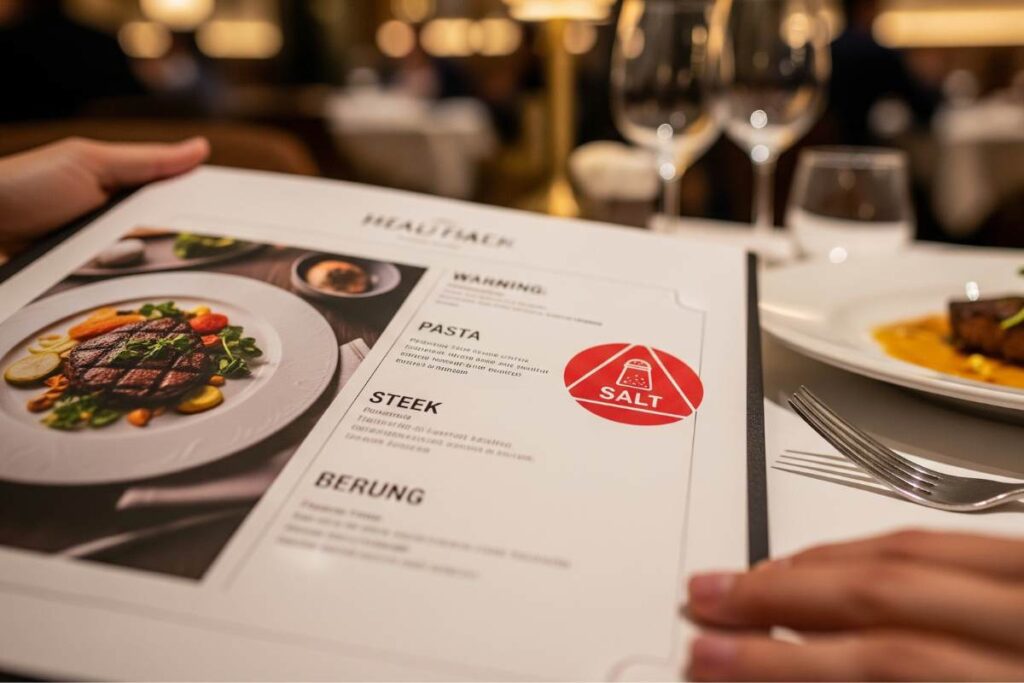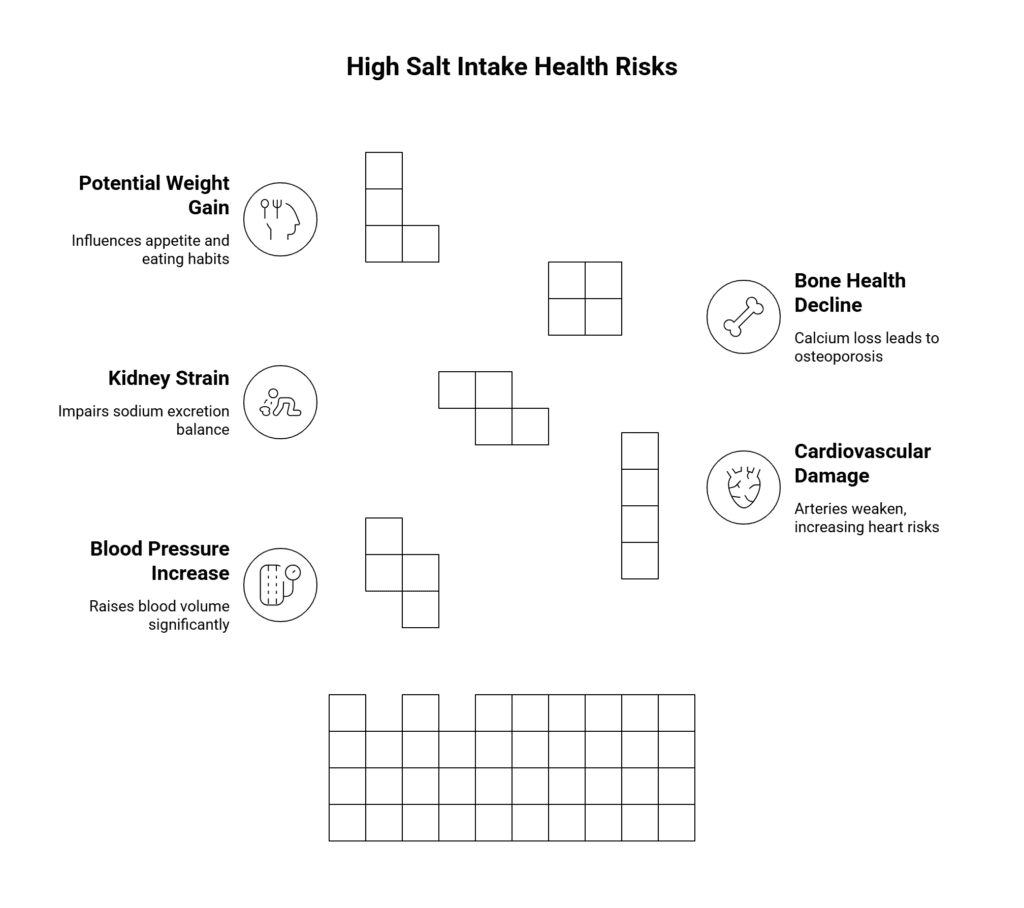Salt’s Place at the Table
Salt. Everybody craves it, often without even noticing. It hides in soups, seasonings, breads, curries, and sauces, making up much of what we eat out. The funny thing is, most diners don’t pause to ask: “Just how much sodium did I swallow?” But as medical evidence piles up, the world’s health authorities have begun to worry about just that. Here’s the kicker: fresh research now shows that slapping clear salt warning labels onto restaurant menus can nudge people, sometimes dramatically, toward lower-salt options. Before you order your next plate of fries, let’s unpack these new findings and what they mean for your health, favorite restaurants, and even national food policy.
Why We Care: Salt Intake and Health Catastrophes
Excess salt rarely feels like a crisis when you’re chewing. But, according to the World Health Organization (WHO), adults should consume less than 5g a day (that’s under a teaspoon). Now, here’s the alarming part: globally, 1.89 million deaths per year are linked directly to too much sodium.
Salt overload raises blood sodium, which triggers water retention, leading to higher blood volume. The fallout? Elevated blood pressure, or hypertension. Untreated, it’s a ticket to strokes, cardiovascular disease, kidney damage, osteoporosis, and even obesity. And with restaurant food often stuffed with ‘invisible salt,’ eating out can sabotage even a well-intentioned diet.
So, could a tiny label on a menu save lives? Turns out, it might do just that.
What Happened: Salt Warning Labels Unveiled
The Research Setup
Researchers in the UK, led by teams at the University of Liverpool, decided to put the theory to the test with a pair of rigorous randomized controlled trials (RCTs).
- Trial 1: Real-world restaurant experiment, 454 participants.
- Trial 2: Online menu simulation, 2,391 UK adults.
Participants received menus either with or without salt warning labels, bright triangles or octagons signaling dishes with high sodium. Some featured a red triangle for visibility; others, black or red octagons. The control group got standard menus.
Impact on Choices and Salt Consumption

The results? Far from subtle.
- Restaurant Setting: Diners given labelled menus ordered meals with 12.5% less salt, about 0.54g less per meal, compared to those with ‘unlabelled’ menus.
- Online Setting: Participants selected food with 0.26g less salt per meal after seeing labels. That’s a 7–8% drop per restaurant meal, and around 8.5% less per packaged item at supermarkets.
Funny thing is, every label worked, black, red, triangle, octagon, but the red octagon prompted the most dramatic reduction in high-salt selections.
And here’s something reassuring: labels moved behavior across the board. Age, gender, and educational background didn’t matter. All groups responded. Salt warning labels offered equal nudge power, so the policy won’t sharpen health inequalities.
Peeling Back Why It Works
So, why do these little symbols push people to rethink dinner? Turns out, it’s all about visibility and simplicity.
- A clear label, right next to the menu item, instantly brings salt content into focus, without you tracking down microprint nutrition panels.
- Most people don’t know recommended salt limits or which dishes are the big offenders. When the label calls out hidden salt, the choice feels straightforward: avoid the one with a warning.
- Researchers found that labelled menus made customers 19 times more likely to think about salt content as they ordered.
Quote from Dr. Rebecca Evans, lead researcher:
“Our study has found that salt warning labels on menus help people make healthier choices. Given that excess salt intake is a leading cause of diet-related disease, this kind of labeling policy could play a vital role in improving population health”.
How Diners Reacted: Not Just Numbers
Of course, not everyone changed their order; some still went for the salty option. But, most found the warnings helpful. Labels were rated as not just clear, but meaningful. They brought a real, immediate awareness that was missing before. A few saw the label and shrugged it off, but for the majority, it triggered a pause. “Do I want, or need, this much salt right now?”
Some consumers shared that they felt labels were especially valuable for people with health concerns, hypertension, kidney disease, or diets needing tight sodium control. Parents said warning labels made it easier to pick meals for kids; others that it felt reassuring simply to know what they were eating.
Global Context: Menu Warnings and Policy Change
India, as it happens, is considering similar steps. The country’s food regulator is actively exploring front-of-pack warnings for foods high in salt, sugar, and fat, a move aimed at dialing down ultra-processed food intake. The global mood is shifting. Countries like the US and UK have started testing salt warnings in restaurants and supermarkets. In places like Chile and Uruguay, front-of-package (FOP) warning labels for high-salt, high-fat, or sugar foods have shown marked success. “Clear and visible warnings help people avoid the unhealthiest purchases,” says a Pan-American Health Organization report.
And, for restaurants themselves? An unexpected benefit: menu labelling might push chefs and food companies to reformulate recipes, lowering salt at the source over time.
What Do These Labels Look Like?
- A red triangle or octagon beside the menu item, a universal sign of warning, not quite “danger!”, but a signal: “Hey, this dish is high in salt.”
- Simple, explicit text. No tricks. No ambiguous icons.
Researchers tested design variations, but the message was clear: as long as the label stood out and was easy to understand, results followed. The red octagon edged out the others in effectiveness, but all forms worked, as long as they were visible, unambiguous, and included a plain-language warning.
The Science Behind the Salt: Physiological Damage Explained

Let’s step back and peek at what all this sodium does inside the human body.
- Blood Pressure: Salt raises sodium levels in your bloodstream. More sodium equals more water held in the body. That bumps up blood volume…and blood pressure.
- Cardiovascular Chaos: Over time, high pressure wears down arteries, boosting risks for heart attacks and strokes.
- Kidneys & Water Balance: Kidneys struggle to balance sodium excretion; too much salt leads to kidney strain, and eventually damage.
- Bone Health: Salt leeches calcium from bones, paving the way for osteoporosis.
- Obesity Linkages: Some studies suggest excess salt can make you gain weight, partly by influencing appetite and eating patterns.
Salt: The Sneaky Ingredient in Everyday Foods
Think it’s only junk food? Think again. Restaurant staples, bread, soups, curries, fried foods, salads, often pack more sodium than a day’s worth in a single serving. Sometimes, even meals that taste “healthy” hide heavy doses. Supermarkets? Packaged items frequently exceed half the recommended daily salt limit in a single portion.
This makes warnings doubly important in commercial kitchens and chains, where corporate recipes rarely change unless flagged by policy or public scrutiny.
How Do These Warnings Compare to Other Nutrition Labels?
Salt warnings aren’t the only game in town. Many countries have tried nutrient warnings for sugar, fat, and calories.
But here’s the twist: salt warnings, especially big and bold, may be the most universally effective. Studies show that consumers find FOP (front-of-package) warnings simpler, more “see it, get it”, than nutrition panels or traffic-light systems. You don’t need to tally grams or study nutritional science. If the dish flashes a “high salt” warning, most people look for another option.
Policy Challenges: Will Restaurants Play Ball?
Rolling out menu warnings won’t be simple. Restaurants must identify which dishes pass the threshold and relabel promptly. Regulations vary: New York City, for example, uses a limit of 2,300mg sodium per item; the UK study flagged dishes at 3g or more. Unless policies define “high salt” clearly and consistently worldwide, there’s a risk of confusion for both eateries and diners.
Also, let’s not forget, change takes time. Initial data from New York showed little immediate reformulation of dishes, though purchases of high-sodium items did decline. Restaurant owners may need prompts, incentives, or simply more time to adjust recipes.
Beyond the Restaurant: The Ripple Effect
Funny thing is, once warning labels hit menus, ripple effects sweep across the food environment.
- Packaged Foods: Warning labels reduce salt purchases not just in restaurants, but at the supermarket. Consumers start to check, consciously or unconsciously.
- Industry Reformulation: Food companies notice shifting customer preferences; some quietly lower sodium in recipes, hoping their products escape the warning label altogether.
- Health Awareness: As labels become routine, salt consumption peaks fade. The population, you, your family, people everywhere, tips toward the WHO-recommended daily limits.
Not Just Numbers: What People Say
Interesting as the numbers are, it’s worth pausing on the voices behind the statistics. From Liverpool to Beijing, public health researchers and consumers alike echo similar themes.
- “Clear labels make me feel safer ordering food for my kids,” one parent shared.
- “Now I know I can avoid the salty stuff; before, it all looked the same.”
- “Honestly, if there’s a warning, I think twice. Not every time, but more than before.”
Some downplay the power of labels: “If I want to eat it, I’ll eat it,” one diner shrugged. But, in aggregate, labels move the needle for the population, and that’s where lives, health budgets, and policies change.
Implementation in India: What’s Next?
India’s food regulator (FSSAI) has publicly acknowledged the need for stronger labeling policies. Discussions include front-of-pack warnings for salt, sugar, and saturated fat on packaged goods and restaurant menus. Given India’s rising rates of hypertension and cardiovascular disease, and with eating out part of urban and rural life, a national rollout could redefine public health, sparking shifts in recipes, supermarket offerings, and consumer habits.
The Small Nudge with a Big Impact
What this clutch of studies makes clear is surprising, not just the effect size (sometimes double-digit percentage drops), but the fact that a “little nudge” at the point of purchase can make a real, immediate difference in public health.
As a policymaker, Dr. Evans put it:
“Even small nudges at the point of purchase can encourage healthier choices”.
Salt warning labels won’t banish sodium from every plate overnight. But they help diners make informed choices, nudging us back toward healthier living, one meal at a time.
Bottom Line: Eat With Your Eyes Open
To wrap up, the evidence tells a simple story. Next time you scan a restaurant menu, don’t be surprised if you see a bright red triangle or octagon next to certain dishes. That little warning may help you, and millions more, make smarter, healthier decisions about what lands on your plate.
After all, in a world drowning in sodium, even a tiny triangle might just be the sharpest tool we’ve got.
Key Takeaways
- Salt warning labels on menus help people reduce their sodium intake by as much as 12.5% per meal in real-world trials.
- All versions of the label (triangle, octagon, red, black) work, but red octagons deliver the biggest impact.
- The effect holds for every demographic group, with no added health inequalities.
- With 1.89 million annual deaths linked to excessive salt, these tiny warnings may save lives, prevent strokes, heart attacks, and kidney disease.
- India and other nations are considering rolling out similar policies for both restaurants and packaged foods.
- Menu labels prompt diners and the food industry alike to rethink how much salt we need.
Remember: knowledge is power, and sometimes, it comes in a tiny, salty triangle.








